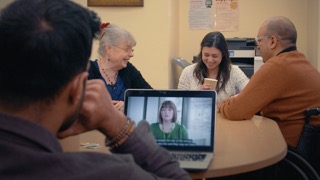 User Experiences and Benefits to Organizations
User Experiences and Benefits to Organizations
Understand the User Needs and Experiences of People with Disabilities
It’s useful to first understand the user experiences of people with disabilities. Then you’ll know the “why” behind the media accessibility requirements in this resource. For example, a person who is Deaf can’t hear the audio, so you need to provide important audio information in another form.
- Many people who are Deaf can read text well. They get the audio information from transcripts or captions. Some people prefer sign language.
- Some people who are hard of hearing like to listen to the audio to hear what they can, and have captions to fill in what they can’t hear adequately.
- Some people who have difficulty processing auditory information also use captions. Many use transcripts so they can read at their own pace.
- Some people who are blind or have low vision can’t see videos well or at all. They use description of visual information to understand what’s going on visually. (Description is called audio description, video description, or described video.)
- Some people who are Deaf-blind use a screen reader and braille to read descriptive transcripts that include the audio and visual information as text.
- Some people cannot focus and comprehend auditory or visual information when there are changing visuals. For most videos, they also need descriptive transcripts.
- Some people cannot use their hands and use speech recognition software to operate their computer, including the media player. And people who are blind need the media player to work without a mouse.
- Some people use multiple accessibility features simultaneously. For example, someone might want captions, description of visual information as text, and description in audio.
If you want to learn more, see these other resources:
- How People with Disabilities Use the Web
- Media Accessibility User Requirements
- Involving Users in Web Projects for Better, Easier Accessibility
Used by People With and Without Disabilities
Accessible media is essential for people with disabilities, and is useful for everyone. Accessibility features are also used by people without disabilities in a variety of situations.
For example, transcripts can be:
- Skimmed or read rather than watched or listened to. This is significantly easier and quicker for many users. Sometimes people want to skim the transcript first before deciding whether or not to play the media.
- Used without needing to download video files. For example, to save data on mobile.
- Used offline, printed, or converted to braille.
And captions can be used:
- In loud environments where users cannot hear the audio. For example, a bar, an airport, or a concert.
- In quiet environments where users cannot turn on sound. For example, in a library, on public transportation, or when others are sleeping.
- By people who cannot understand the spoken language well and can understand the written language better. For example, people who are not native speakers of the language.
- By people learning to read, including people learning a new language.
- To better understand content because users can hear the information in audio and see it in text at the same time. For example, a Research Study of Closed Captions & Transcripts found that 71% of students without hearing difficulties use captions, primarily to help them focus and retain information.
Benefits to Organizations
Organizations that make their audio and video accessible can realize benefits such as:
- Increased traffic and website use by people with and without disabilities, for example, in the situations described above.
- Better user experience for all and improved customer satisfaction.
- Better indexing by search engines.
Benefits to organizations are illustrated in these other resources:
- The business case includes case study data from adding transcripts, and more on how accessibility can increase your market reach.
- Benefits of transcripts and captions to a university are mentioned in a user story/persona of an online student who is hard of hearing.
- Some benefits of captions are illustrated in a 1-minute Video on Captions.

This resource helps make your media usable by people with and without disabilities, and benefit your organization. The next page gets you started Planning Accessible Audio and Video Media.
Back to Top